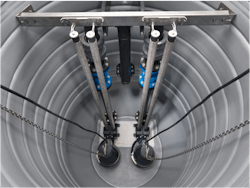Grundfos Analyzes IEC Motor Efficiency Standards for Wastewater
IE3 Premium efficiency is currently the gold standard for single-speed, three-phase cage-induction motors, at least until IE4 is introduced later in 2014—an issue Grundfos addresses in the its latest technical article.
But can IE standards really be applied to motors designed to operate wholly submerged in a liquid? Or what about motors completely integrated into a product, so the motor’s efficiency cannot be tested independently from the product?
The fact is, it is impossible for any manufacturer to supply a wastewater pump with an integrated motor that is IE compliant, because there is no applicable standard on efficiency definitions for wastewater pumps with integrated motors.
Some customers may believe that their specifications require the IE3 classification for a pump with an integrated motor. In fact, their tender documents may specify this.
But even if the motor on a wastewater pump is IE3, said Robert Bork Hansen of Grundfos, other factors come into play.
“What makes the wastewater pump motor differ from the conventional IE3 motor are the bearings, mechanical seals, and the absence of fan cooling,” Bork said. “In wet installations, cooling is provided by the fluid in which the pump is submerged.”
Bork said the rotors and the stators on the Grundfos IE3 motor are type test certified, in accordance with the TEFC motor standard and supported by measurement reports.
“So for all intents and purposes, it is an IE3 compliant motor,” Bork said. “However, by changing the bearings, adding a mechanical shaft seal and altering the method of cooling, the IE3 motor compliancy is negated.”
Because it is impossible to claim that a wastewater pump that contains an integral motor is IE2 or IE3 compliant, Grundfos has suggested a solution to address the subject of pump and motor efficiency. Grundfos SE1/SEV and SL1/SLV wastewater pumps now incorporate the electrical internals, i.e. the rotor and stator, of the IE3 motor in the stator housing.
“In recent years an energy standard has been produced for small circulator pumps where, like wastewater and submersible pumps, the motor and shaft are contained in a single housing and cannot be tested separately,” said Grundfos’ Mikael Nedergaard.
Endorsed by the EU, the standard drawn up by Europump, the pump manufacturers’ trade association and pump manufacturers consists of seven classifications of energy saving, he explained.
“The energy efficiency index (EEI) of the pump is calculated according to an annual load profile and the pump is labelled according to its energy efficiency. With the introduction of new energy labelling, the end user will be able to compare products and specify the most appropriate pump or pumps for the installation,” Nedergaard said.
Read Grundfos' technical analysis to learn more about the standards.
Source: Grundfos
